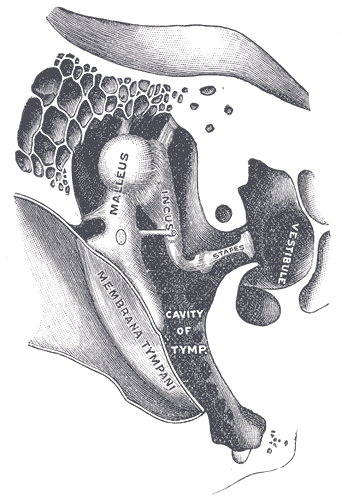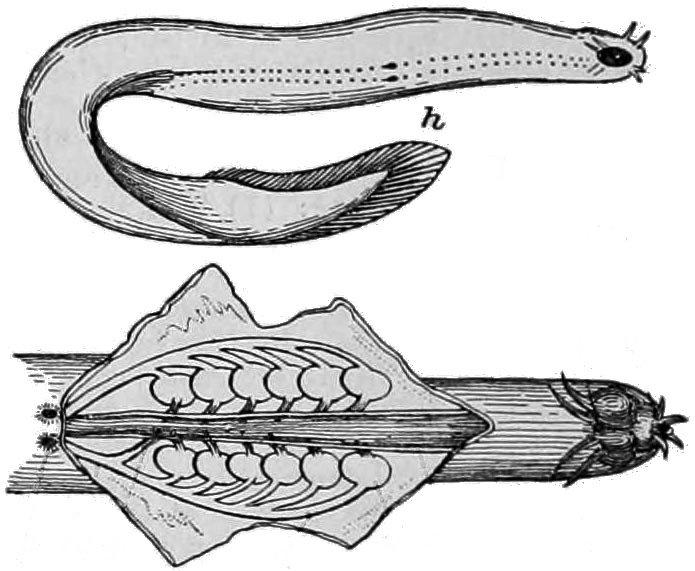|
Hearing In Fish
Most fish possess highly developed sense organs. Nearly all daylight fish have colour vision that is at least as good as a human's (see vision in fish). Many fish also have chemoreceptors that are responsible for extraordinary senses of taste and smell. Their hearing is well-adapted for the underwater environment, using bone conduction, the swim bladder, and the inner ear. Most fish have sensitive receptors that form the lateral line system, which detects gentle currents and vibrations, and senses the motion of nearby fish and prey. Sharks can sense frequencies in the range of 25 to 50 Hz through their lateral line. Fish orient themselves using landmarks and may use mental maps based on multiple landmarks or symbols. Fish behavior in mazes reveals that they possess spatial memory and visual discrimination. Vision Vision is an important sensory system for most species of fish. Fish eyes are similar to those of terrestrial vertebrates like birds and mammals, but have a ... [...More Info...] [...Related Items...] OR: [Wikipedia] [Google] [Baidu] |
Vision In Fish
Visual system, Vision is an important sensory system for most species of fish. Fish eyes are similar to the eyes of terrestrial animal, terrestrial vertebrates like bird vision, birds and mammals, but have a more spherical lens (anatomy), lens. Birds and mammals (including humans) normally adjust Focus (optics), focus by changing the shape of their lens, but fish normally adjust focus by moving the lens closer to or further from the retina. Fish retinas generally have both rod cells and cone cells (for scotopic vision, scotopic and photopic vision), and most species have colour vision. Some fish can see ultraviolet and some are sensitive to polarised light. Among jawless fishes, the lamprey has well-developed eyes, while the hagfish has only primitive eyespot (mimicry), eyespots. See alsLamb et al.'s The origin of the Vertebrate Eye, 2008./ref> The ancestors of modern hagfish, thought to be the protovertebrate, were evidently pushed to very deep, dark waters, where they were le ... [...More Info...] [...Related Items...] OR: [Wikipedia] [Google] [Baidu] |
Ultraviolet
Ultraviolet radiation, also known as simply UV, is electromagnetic radiation of wavelengths of 10–400 nanometers, shorter than that of visible light, but longer than X-rays. UV radiation is present in sunlight and constitutes about 10% of the total electromagnetic radiation output from the Sun. It is also produced by electric arcs, Cherenkov radiation, and specialized lights, such as mercury-vapor lamps, tanning lamps, and black lights. The photons of ultraviolet have greater energy than those of visible light, from about 3.1 to 12 electron volts, around the minimum energy required to ionize atoms. Although long-wavelength ultraviolet is not considered an ionizing radiation because its photons lack sufficient energy, it can induce chemical reactions and cause many substances to glow or fluoresce. Many practical applications, including chemical and biological effects, are derived from the way that UV radiation can interact with organic molecules. The ... [...More Info...] [...Related Items...] OR: [Wikipedia] [Google] [Baidu] |
Hearing (sense)
Hearing, or auditory perception, is the ability to perceive sounds through an organ, such as an ear, by detecting vibrations as periodic changes in the pressure of a surrounding medium. The academic field concerned with hearing is auditory science. Sound may be heard through solid Solid is a state of matter where molecules are closely packed and can not slide past each other. Solids resist compression, expansion, or external forces that would alter its shape, with the degree to which they are resisted dependent upon the ..., liquid, or gaseous matter. It is one of the traditional five senses. Partial or total inability to hear is called hearing loss. In humans and other vertebrates, hearing is performed primarily by the auditory system: mechanical waves, known as vibrations, are detected by the ear and transduction (physiology), transduced into nerve impulses that are perceived by the brain (primarily in the temporal lobe). Like touch, audition requires sensitivity ... [...More Info...] [...Related Items...] OR: [Wikipedia] [Google] [Baidu] |
Wavelength
In physics and mathematics, wavelength or spatial period of a wave or periodic function is the distance over which the wave's shape repeats. In other words, it is the distance between consecutive corresponding points of the same ''phase (waves), phase'' on the wave, such as two adjacent crests, troughs, or zero crossings. Wavelength is a characteristic of both traveling waves and standing waves, as well as other spatial wave patterns. The multiplicative inverse, inverse of the wavelength is called the ''spatial frequency''. Wavelength is commonly designated by the Greek letter lambda (''λ''). For a modulated wave, ''wavelength'' may refer to the carrier wavelength of the signal. The term ''wavelength'' may also apply to the repeating envelope (mathematics), envelope of modulated waves or waves formed by Interference (wave propagation), interference of several sinusoids. Assuming a sinusoidal wave moving at a fixed phase velocity, wave speed, wavelength is inversely proportion ... [...More Info...] [...Related Items...] OR: [Wikipedia] [Google] [Baidu] |
Light
Light, visible light, or visible radiation is electromagnetic radiation that can be visual perception, perceived by the human eye. Visible light spans the visible spectrum and is usually defined as having wavelengths in the range of 400–700 nanometres (nm), corresponding to frequency, frequencies of 750–420 terahertz (unit), terahertz. The visible band sits adjacent to the infrared (with longer wavelengths and lower frequencies) and the ultraviolet (with shorter wavelengths and higher frequencies), called collectively ''optical radiation''. In physics, the term "light" may refer more broadly to electromagnetic radiation of any wavelength, whether visible or not. In this sense, gamma rays, X-rays, microwaves and radio waves are also light. The primary properties of light are intensity (physics), intensity, propagation direction, frequency or wavelength spectrum, and polarization (waves), polarization. Its speed of light, speed in vacuum, , is one of the fundamental physi ... [...More Info...] [...Related Items...] OR: [Wikipedia] [Google] [Baidu] |
Water
Water is an inorganic compound with the chemical formula . It is a transparent, tasteless, odorless, and Color of water, nearly colorless chemical substance. It is the main constituent of Earth's hydrosphere and the fluids of all known living organisms (in which it acts as a solvent). It is vital for all known forms of life, despite not providing food energy or organic micronutrients. Its chemical formula, , indicates that each of its molecules contains one oxygen and two hydrogen atoms, connected by covalent bonds. The hydrogen atoms are attached to the oxygen atom at an angle of 104.45°. In liquid form, is also called "water" at standard temperature and pressure. Because Earth's environment is relatively close to water's triple point, water exists on Earth as a solid, a liquid, and a gas. It forms precipitation in the form of rain and aerosols in the form of fog. Clouds consist of suspended droplets of water and ice, its solid state. When finely divided, crystalline ice ... [...More Info...] [...Related Items...] OR: [Wikipedia] [Google] [Baidu] |
Deep Sea Fish
Deep-sea fish are fish that live in the darkness below the sunlit surface waters, that is below the epipelagic or photic zone of the sea. The lanternfish is, by far, the most common deep-sea fish. Other deep-sea fishes include the flashlight fish, cookiecutter shark, bristlemouths, anglerfish, viperfish, and some species of eelpout. Only about 2% of known marine species inhabit the pelagic environment. This means that they live in the water column as opposed to the benthic organisms that live in or on the sea floor. Deep-sea organisms generally inhabit bathypelagic ( deep) and abyssopelagic ( deep) zones. However, characteristics of deep-sea organisms, such as bioluminescence can be seen in the mesopelagic ( deep) zone as well. The mesopelagic zone is the disphotic zone, meaning light there is minimal but still measurable. The oxygen minimum layer exists somewhere between a depth of depending on the place in the ocean. This area is also where nutrients are most abundant. The ... [...More Info...] [...Related Items...] OR: [Wikipedia] [Google] [Baidu] |
Adaptation
In biology, adaptation has three related meanings. Firstly, it is the dynamic evolutionary process of natural selection that fits organisms to their environment, enhancing their evolutionary fitness. Secondly, it is a state reached by the population during that process. Thirdly, it is a phenotypic trait or adaptive trait, with a functional role in each individual organism, that is maintained and has evolved through natural selection. Historically, adaptation has been described from the time of the ancient Greek philosophers such as Empedocles and Aristotle. In 18th and 19th-century natural theology, adaptation was taken as evidence for the existence of a deity. Charles Darwin and Alfred Russel Wallace proposed instead that it was explained by natural selection. Adaptation is related to biological fitness, which governs the rate of evolution as measured by changes in allele frequencies. Often, two or more species co-adapt and co-evolve as they develop adaptations tha ... [...More Info...] [...Related Items...] OR: [Wikipedia] [Google] [Baidu] |
Jane Reece
Jane B. Reece (born April 15, 1944) is an American scientist and textbook author. Along with American biologist Neil Campbell (scientist), Neil Campbell, she wrote the widely used ''Campbell Biology, Campbell/Reece Biology'' textbooks. Following Campbell's death in 2004, she collaborated with American biologist Lisa Urry to update subsequent editions. The textbook is widely acclaimed and is used in 90 percent of AP Biology classes and 60 percent of introductory college biology courses. The textbook has been used by over 14 million students and has been translated into over 20 languages. Early life and education Reece received an A.B. in Biology from Harvard University, an M.S. in Microbiology, microbiology from Rutgers University, and a Ph.D. in Bacteriology, bacteriology from the University of California, Berkeley. Her doctoral thesis was entitled ''The RecE pathway of genetic combination in Escherichia Coli'' (1981). Having completed her Ph.D., she stayed at UC Berkeley for a w ... [...More Info...] [...Related Items...] OR: [Wikipedia] [Google] [Baidu] |
Neil A
Neil is a masculine name of Irish origin. The name is an anglicisation of the Irish '' Niall'' which is of disputed derivation. The Irish name may be derived from words meaning "cloud", "passionate", "victory", "honour" or "champion".. As a surname, Neil is traced back to Niall of the Nine Hostages who was an Irish king and eponymous ancestor of the Uí Néill and MacNeil kindred. Most authorities cite the meaning of Neil in the context of a surname as meaning "champion". Origins The Gaelic name was adopted by the Vikings and taken to Iceland as ''Njáll'' (see Nigel). From Iceland it went via Norway, Denmark, and Normandy to England. The name also entered Northern England and Yorkshire directly from Ireland, and from Norwegian settlers. ''Neal'' or ''Neall'' is the Middle English form of ''Nigel''. As a first name, during the Middle Ages, the Gaelic name of Irish origins was popular in Ireland and later Scotland. During the 20th century ''Neil'' began to be used in England and N ... [...More Info...] [...Related Items...] OR: [Wikipedia] [Google] [Baidu] |
Eyespot (mimicry)
An eyespot (sometimes ocellus) is an eye-like marking. They are found in butterflies, reptiles, cats, birds and fish. Eyespots could be explained in at least three different ways. They may be a form of mimicry in which a spot on the body of an animal resembles an eye of a different animal, to deceive potential predator or prey species. They may be a form of self-mimicry, to draw a predator's attention away from the prey's most vulnerable body parts. Or they may serve to make the prey appear inedible or dangerous. Eyespot markings may play a role in intraspecies communication or courtship; a well-known example is the eyespots on a peacock's display feathers. The pattern-forming biological process (morphogenesis) of eyespots in a wide variety of animals is controlled by a small number of genes active in embryonic development, including the genes called Engrailed, Distal-less, Hedgehog, Antennapedia, and the Notch signaling pathway. Artificial eyespots have been shown to reduce ... [...More Info...] [...Related Items...] OR: [Wikipedia] [Google] [Baidu] |
Hagfish
Hagfish, of the Class (biology), class Myxini (also known as Hyperotreti) and Order (biology), order Myxiniformes , are eel-shaped Agnatha, jawless fish (occasionally called slime eels). Hagfish are the only known living Animal, animals that have a skull but no vertebral column, although they do have rudimentary vertebrae. Hagfish are marine animal, marine predators and scavengers that can defend themselves against other larger predators by releasing copious amounts of slime coat, slime from mucous glands in their skin. Although their exact relationship to the only other extant taxon, living group of Agnatha, jawless fish, the lampreys, was long the subject of controversy, genetic evidence suggests that hagfish and lampreys are more closely related to each other than to jawed vertebrates, thus forming the superclass Cyclostomi. The oldest-known stem group hagfish are known from the Pennsylvanian (geology), Late Carboniferous, around Moscovian (Carboniferous), 310 million years ... [...More Info...] [...Related Items...] OR: [Wikipedia] [Google] [Baidu] |




